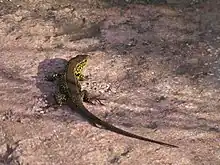Greek algyroides
The Greek algyroides (Algyroides moreoticus), or Greek keeled lizard, is a species of lizard in the family Lacertidae. It is endemic to Greece.
| Greek algyroides | |
|---|---|
 | |
| Male, Kefalonia | |
 | |
| Young male, Peloponnese | |
| Scientific classification | |
| Domain: | Eukaryota |
| Kingdom: | Animalia |
| Phylum: | Chordata |
| Class: | Reptilia |
| Order: | Squamata |
| Family: | Lacertidae |
| Genus: | Algyroides |
| Species: | A. moreoticus |
| Binomial name | |
| Algyroides moreoticus | |
Classification
The Greek algyroides was first formally described in 1833 by the French biologists Gabriel Bibron and Jean-Baptiste Bory de Saint-Vincent with its type locality given as "Koubeh" in the Peloponnese.[2] Algyroides moreoticus is the type species of the genus Algyroides which is classified within the tribe Lacertini of the subfamily Lacertinae in the family Lacertidae, the "typical lizards" or "wall lizards" of Africa and Eurasia.[3]
Description
The Greek algyroides is a small lizard[4] with the typical large, keeled scales of the genus Algyroides on their backs.[2] The males are more colourful than the inconspicuous, brownish females and different populations have differing colour patterns on their flanks. The males on Zakynthos have yellow colour on their flanks, thise on Kefalonia and Ithaka have blue flanks while those on the mainland Peloponnese have black and white flanks.[4]
Distribution and habitat
The Greek algyroides is endemic to Greece where it is found on the Peloponnese Peninsula and the Ionian Island of Zakynthos, Kefalonia, Ithaka and on the Strofades, It is found in open woods, hedgerows and on the margins of farmland where there is shade or partial shade. These lizards seem to prefer damp areas and to hides among ground cover, like brushwood and leaf litter.[1]
Biology
The Greek algyroides may be often be encountered basking on wood or tree trunks in the late afternoon, in the hotter months of summer they can be more cryptic in behaviour.[4] The female Greek algyroides lay only a few eggs in each clutch.[1]
Conservation status
The Greek algyroides is classified as near threatened by the IUCN, the main threat being habitat loss.[1]
References
- Wolfgang Böhme, Petros Lymberakis (2009). "Algyroides moreoticus". IUCN Red List of Threatened Species. 2009: e.T61465A12489765. doi:10.2305/IUCN.UK.2009.RLTS.T61465A12489765.en. Retrieved 16 November 2021.
- "Algyroides moreoticus BIBRON & BORY, 1833". The Reptile Database. Retrieved 10 April 2023.
- Arnold, E. Nicholas; Arribas, Oscar; Carranza, Salvador (2007). "Systematics of the Palaearctic and Oriental lizard tribe Lacertini (Squamata: Lacertidae: Lacertinae), with descriptions of eight new genera". Zootaxa. 1430: 1–86. doi:10.11646/zootaxa.1430.1.1. ISBN 978-1-86977-097-6. Retrieved 12 July 2017.
- "Algyroides moreoticus - Greek Algyroides". Eurolizards. Retrieved 10 April 2023.
Further reading
- Arnold EN, Burton JA (1978). A Field Guide to the Reptiles and Amphibians of Britain and Europe. London: Collins. 272 pp. + Plates 1-40. ISBN 0-00-219318-3. (Algyroides moreoticus, p. 118 + Plate 18 + Map 57).
- Boulenger GA (1887). Catalogue of the Lizards in the British Museum (Natural History). Second Edition. Volume III. Lacertidæ ... London: Trustees of the British Museum (Natural History). (Taylor and Francis, printers). xii + 575 pp. + Plates I-XL. ("Algiroides [sic] moreoticus ", p. 45).
